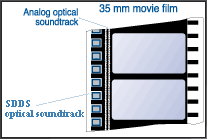 |  |  | |
| IMAX DDP | Dolby SR-D | DTS | Sony SDDS |
| introduced 1988 | introduced 1991 | introduced 1993 | introduced 1993 |
| by Sonic Associates | by Dolby Laboratories | by Digital Theater Systems | by Sony Electronics |
 |  |  | |
| IMAX DDP | Dolby SR-D | DTS | Sony SDDS |
| introduced 1988 | introduced 1991 | introduced 1993 | introduced 1993 |
| by Sonic Associates | by Dolby Laboratories | by Digital Theater Systems | by Sony Electronics |
1990 - Dick Tracy released June 15 as the first 35mm feature film distributed with a digital soundtrack by Cinema Digital Sound (CDS), developed by Eastman Kodak and Optical Radiation Corp. "The system was set up in the typical Left, Center, Right, Right Surround, Left Surround, LFE channel format. CDS encoded 16-bit PCM audio in a compression process called Delta Modulation. The process is very similar to normal PCM coding, but with one major difference. PCM coding records the intensity of every sample to a zero db level. That requires 16-bits for each sample. Delta Modulation records the intensity differences of successive samples, and that doesn't require nearly as much data. The compression level of CDS ran approximately 4:1." (quote from Bobby Henderson, CDS) However, the system replaced the optical analog soundtrack without allowing any backup track for theaters not equipped with the $20,000 digital playback system. Also, theaters preferred to wait for the Dolby digital system that was compatible with an analog track.
1992 - Batman Returns premiered June 19 in 10 theatres equipped with new Dolby DA10 Digital Film Sound Processor
1993 - Jurassic Park released May 30 as the first film with DTS sound, developed by Terry Beard, founder of Digital Theater Systems in Westalke Village, CA, partly owned by Steven Speilberg and Universal Pictures. This digital sound film format records 6 tracks on separate CD-ROM disks, synchronized by an optical timecode track recorded on the film, co-existing with a backup optical soundtrack similar to Dolby Stereo.
1993 - Last Action Hero released July 18 using the Sony Dynamic Digital Sound (SDDS) digital sound film format that put 6 or 8 tracks of digital sound on 2 optical stripes on each edge of the film strip, recorded on the cyan layer beneath the other emulsion layers, using the lossy ATRAC algorithm of the Sony Minidisc technology with a compression ratio of 5:1, dynamic range of 105db and a frequency response from 5-20,000Hz. It is compatible with a backup standard optical soundtrack such as Dolby SR.
 |
1996 - DTS trailer film for Jurassic Park: The Lost World released: "The teaser trailer, which debuted on December 13 at forty locations in the United States and two in Toronto, Canada, is driven by a modified DTS that activated six stategically placed strobe lights employed to comlement the images that appear on the screen. Using DTS technology, the timing for the strobe lights is encoded into the trailer's print, which is synched to the highly reliable DTS CD-ROM system. Audiences viewing the teaser trailer feel as if they are caught in a rainstorm complete with life-like sound and lightning provided by the strobe lights." (press release from DTS).
1996 - The English Patient was the first Oscar-winning American film with a digitally edited soundtrack, winning Walter Murch two Academy Awards for film and sound editing.
1998 - Dolby became the leading producer of motion picture sound processors used in theaters worldwide with over 50,000 sold; projector attachments such as the CP500 digital cinema processor introduced in 1995 were capable of decoding 2 of the 4 soundtracks recorded on most film prints (see chart at right from Audio).
1998 - The Last Broadcast premiered Oct. 19 as "the first desktop feature film" produced and exhibited digitally, co-sponsored by Texas Instruments using its DLP digital cinema projector.
1999 - Star Wars: Episode I - The Phantom Menace was released May 19 in the U.S. with Dolby Digital Surround EX providing an added rear center audio channel. On June 18, it was the first major studio motion picture to be exhibited in digital cinema in 4 theaters with digital projectors by Texas Instruments and by CineComm.
2000 - Jan. 1 Disney released Fantasia/2000 in the IMAX film format with 6-channel digital sound.